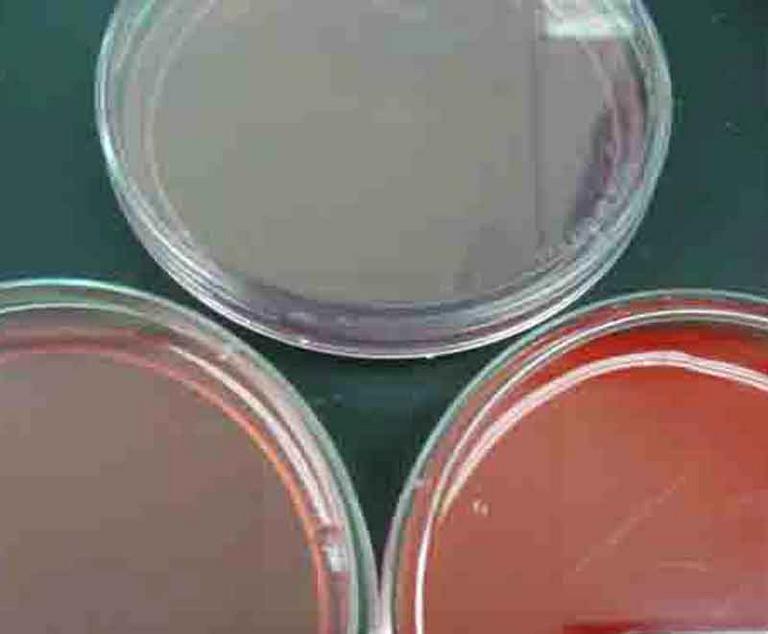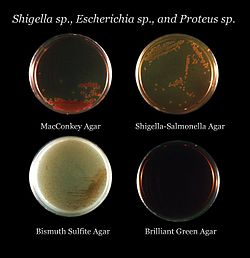Growth medium
A nutrient medium, referred to as culture medium used for cultivation of microorganisms, cells, tissues or small plants, such as the moss Physcomitrella patens. A distinction is made between liquid (for example, bouillon, broth or broth ) and gelled ( "fixed" ) growth media ( soil ).
- 3.1 according to field of application
- 3.2 for ingredients
- 3.3 according to nutrient requirements
- 3.4 on the workload
- 3.5 according to the aim of analysis 3.5.1 selective media
- 3.5.2 Differential Media
Application
Liquid culture media
Liquid culture media are used
- For biotechnological production (see bioreactor )
- For culturing eukaryotic cells (see cell culture ) and microorganisms ( see microorganism culture ) for research purposes
- For the cultivation of living tissues for medical use (e.g. skin grafts )
- For the detection or enrichment of microorganisms ( see enrichment culture )
- To check for certain metabolic activities of microorganisms to their identification (see Bunte Reihe (lab) )
- For the quantification of micro-organisms according to the method of the "most probable number " ( "Most Probable Number ", see MPN method).
Solid culture media ( Gelnährmedien )
Solid growth media is referred to as culture media, which are present by the addition of a gelling agent in form of a gel. Solid culture media are used for analytical purposes, especially because they also allow for quantification of microorganisms: Since the microorganisms can not distribute freely in the medium, they form in their proliferation at all on or in the nutrient medium contained microorganism a visible colony. The number of colonies thus correspond to the ideal case, the initial number of microorganisms. However, as a colony can also be formed of a plurality of closely spaced individual, corresponding to the number of colonies is not the actual number of microorganisms, but only the number of individuals and are distributed in groups in or on the soil microorganisms. These individuals and groups of individuals are referred to as CFU ( colony forming unit also cfu - colony forming units).
Further solid growth media are used when forming on the surface of the Nährmediumgels colonies are to be used with a characteristic appearance for the characterization and identification of microorganisms.
Semi-solid culture media
Semi-solid culture media are primarily used in test tubes as a high- layer tubes, this so-called " soft agar " contains less agar than usual at a fixed nutrient medium. With it, one can prove the active movement by flagella ( motility ) in microorganisms. It is also used to create an oxygen gradient to cultivate microaerophilic organisms, they require a lower concentration of oxygen than in air is present.
Composition
The basic composition of a culture medium usually consists of a major proportion of water, be used by the organism in the energy source (see Chemotrophie ), for example, organic compounds or sulfur containing compounds, and require from him nutrients ( organic or inorganic carbon, nitrogen, sulfur and phosphorus sources as well as other essential nutrients ). The nutrients are called substrates, and are in the nutrient media for heterotrophs mostly carbohydrates ( "sugars" ), protein hydrolysates ( peptones ) and possibly fatty acids. In addition, inorganic salts provide the organism vital ions, such as ammonium, potassium, sodium, phosphate, sulfate, and trace elements.
In addition, may also be present:
- Dyes and their precursors ( microscopy dyes, chromogenic substrates )
- Gelling agent ( hardening agent), such as agar- agar, or ( rarely) gelatin
- Inhibitors ( for example antibiotics ), and selective agents to prevent the growth of undesirable microorganisms (e.g., chloramphenicol for yeast / mold culture media )
- Display indicators to indicate changes, such as the pH, but also with certain products of metabolism or metabolic activities
- Growth factors ( supplines called ), such as hormones, vitamins, and the like.
For the production of a nutrient nutrients and additives are mixed together according to a recipe and ( if necessary by heating with hot, flowing steam ) dissolved in distilled or demineralized water. Subsequently, the sterilization is performed (usually by heating in an autoclave ). Thermolabile additives that would be destroyed by the heat sterilization, sterilized by mechanical means - mostly through a sterile filtration with a membrane filter (clean filter) - and added to the culture medium after the heat sterilization and cooling.
Solid culture media contain at least 1 % agar - agar, depending on the formulation, the concentration varies from 10 to 20 g agar / l culture medium (grams per liter). For a so-called " soft agar " 1-4 g / l are common. Historically, one speaks in aqueous solutions of complex organic substrates of Bouillon, as the first culture media of this type were still made on the basis of soup recipes. Such liquid media are similar in composition to the solid media, only no agar or other gelling agent is contained in them.
Classification
Culture media can be classified according to various criteria:
According to field of application
By ingredients
According to nutrient requirements
On the workload
After investigation target
Using media, in order to select micro-organisms based on specific properties. There are two approaches:
Selective media
Selective media only allow the growth of certain microorganisms having special properties to multiply in this medium. One example is media that is supplemented with antibiotics. In them, only those microorganisms can grow resistant to the antibiotic used.
Differential media
Differential media (including differentiation media or Indikatornährböden called ) allow the growth of several microorganisms used. However, they are so composed that the resulting colonies of different microorganisms differ in appearance, they can be differentiated. For example, on blood agar bacterial strains that are capable of hemolysis can be distinguished from others by the Klärungshof to their colonies.
Frequently, differential media dyes or pH indicators, with which one can make certain metabolic activities of the microorganisms visible. Examples of this are the removal of a carbohydrate by microorganisms under acid formation, it is the pH decreased ( acidic), or the degradation of urea or citrate by bacteria; This produces alkaline degradation products, and the pH value is increased. The change of the pH value is displayed by means of a suitable pH indicator by color change; This results in a discoloration of the medium or of the colonies.
A well-known medium that combines both of these principles, the MacConkey agar. It contains bile salts and crystal violet, and thereby inhibits the growth of gram-positive bacteria, and thus acts as a selective medium. For its effect as a differential medium is contained lactose and neutral so that lactose fermenting bacteria based on a color change of the pH indicator neutral red can be identified. Another commonly used culture medium, which acts both as a selective medium, as well as a differential medium is XLD agar.
Replica Plating
Replica Plating ( to about Replikationsausplattierung German ) refers to the transfer of all colonies from a solid nutrient medium to another solid nutrient medium to obtain the arrangement of the individual colonies to each other. A sterile velvet cloth is on a Lederberg - stamp this tense, which is first then transfer them to a plate with colony and on a bare surface plate by gently pressing. Through the impression is created, a copy of the colonies on the solid culture medium that is cultivated in the emergence of the colonies. The pile fibers of the velvet avoid smearing of the colonies. Before the use of velvet, the transfer of colonies was with sterile toothpicks (after E. Tatum ) or with sterile filter paper carried out ( according to N. Visconti ).









